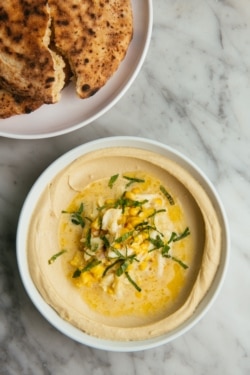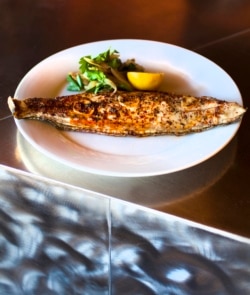"There is nothing in the world like the food you can find in Louisiana," Chef Isaac Toups, owner of popular New Orleans restaurant Toups Meatery, told VOA. "It's such a unique mix of so many different cultures that converged here from around the globe. They brought their ideas about food with them and made a cuisine that is unparalleled."
Immigrants' culinary influences span centuries in New Orleans, a port city near the mouth of the Mississippi River. From French colonists who were the first Europeans to permanently settle in the area in 1699 to Vietnamese immigrants in the 1970s to recent arrivals from all over the world, newcomers have continually added to the DNA of local cuisine.
Liz Williams, founder of the Southern Food and Beverage Museum and author of New Orleans: A Food Biography, says there's something unique about the way cultures – and cooking – have melded in this Southern city compared with other places in America.
"You can find every food in the world in New York City," Williams said. "Go two blocks that way for this type of cuisine and six blocks the other way for that type of cuisine."
New Orleans, by contrast, has spawned a gastronomical melting pot. Or, to use a local analogy, a gumbo.
"There's no 'New York City cuisine' because all those immigrant groups didn't meld together," she said. "In New Orleans, though, all of these different immigrant cuisines have been influenced by New Orleans food and influenced New Orleans food. There's a melding, merging and updating that seems to be constantly happening here that doesn't happen in other places."
Early settlers
Mention Louisiana cooking, and most people think of Creole cuisine, Cajun cuisine or some mixture of the two.
"When the two foods were first being established in Louisiana in the 18th century, they were two distinct cuisines from two distinct regions," explained chef Donald Link, owner of several New Orleans restaurants all under the banner of the Link Restaurant Group. "Creole food was being created in New Orleans while Cajun food was in the more rural, southwestern part of the state."
Creole culture in New Orleans arose from a mixture of the early French settlers, Spanish immigrants who followed shortly after, enslaved people taken from Africa and the Native Americans who were already here. Once the United States purchased Louisiana from France in 1803, waves of Anglo-Americans came to New Orleans as well as thousands who fled the Haitian Revolution taking place at the same time.
The confluence created a unique mix of cultures that is reflected in local cooking to this day.
"New Orleans is often called the most northern city in the Caribbean, and there was a lot of influence coming from Spanish-controlled Latin countries," explained Link. "They brought their rice, beans, guisados and stews. And then the French brought their boudin and fricassees and all these celebrated techniques, and Africans had gumbo, which comes from the West African word for okra. It all came together to make what we call Creole food."
Creole food is considered a cosmopolitan cuisine. It often features rich sauces, local herbs, ripe tomatoes and local seafood.
"You use what you have available to you," said Brad Hollingsworth, owner of longtime New Orleans favorite Clancy's. "Here, that means all these great, fresh fish from the Gulf of Mexico: speckled trout, pompano, red snapper, redfish, flounder and all the way down the line."
Hollingsworth said cuisine from Creole culture is more focused on sauces than its Cajun counterpart. That, he said, is in large part because of the city's ability to attract settlers from more cosmopolitan, cultured areas of France.
"They brought with them the French mother sauces that we really lean into at Clancy's," Hollingsworth said. "Bechamel, velouté, espagnole, hollandaise and tomato. We use them to complement our local fish or meat. It's a combination of using what is geographically available and the techniques of the immigrant groups who came here."
Cajun food, on the other hand, is known for being more rustic. It features meat-heavy, all-in-one-pot dishes like jambalaya and the rice-filled, spicy pork blood sausage known as boudin.
The Cajuns were also largely originally of French descent, but these French-influenced immigrants came from backcountry parts of Acadia in Canada rather than the major cities of France. They were forced out of Canada by the British in 1755, and about 3,000 arrived in rural Louisiana, where they interacted with German immigrants, Native Americans and enslaved people – all of whom added their own culinary influences.
"Cajun cuisine was more of a country food, while Creole cuisine was more of a city food," said Toups, who grew up in the part of Louisiana known as Cajun Country, about two-and-a-half hours west of New Orleans. "That's because the Cajuns were French fur trappers, not French-trained chefs like you might find in the city. As a poorer immigrant group, we had to add things to make our meals last. Fortunately, the region had tons of rice, which is why you find rice in our classics like boudin, jambalaya and gumbo."
Continuing the evolution of a food
During the 19th and 20th centuries, thanks to improved methods of communication and better transportation, the two cuisines began to merge and inspire each other. They also continued to be influenced by other groups
German immigrants, for example, brought their passion for sausages to Cajun food, which helped create Louisiana's famed spicy andouille. But the next big addition to the local food scene came when nearly 300,000 Italian immigrants – most of them Sicilian – moved to the city between 1884 and 1924.
"If you look at stuffed peppers in other places, they're usually prepared with rice," said Liz Williams, who will be releasing the book, Nana's Creole Italian Table in March 2022, "but in New Orleans, our veggies are stuffed with breadcrumbs. That's an effect of the Sicilians who arrived here."
Red gravy, the Creole adaptation of tomato sauce – similar to how Creoles use a roux in gumbo as a thickener – and the introduction of sno-balls, made from shaved ice, to New Orleans are further examples of how New Orleanian and Sicilian cuisines merged.
"In Sicily and lots of Europe, it was common during hotter months to walk up a mountain to collect snow that you could flavor with syrup for a summertime treat," Williams said. "In America, most places use crushed ice for more of a frozen sherbet. In New Orleans, however, shaved ice is used because it emulates more of what our Sicilians knew back home."
In more recent decades, Mexican immigrants came to New Orleans to help rebuild after Hurricane Katrina in 2005. They, too, left an impact on their new home – not just on the cuisine, but also the way it's served.
New Orleans is now dotted with dozens of taco trucks it didn't have before the storm.
"Because the local ingredients are different here," Williams explained, "so are the items sold. You're not going to find fried oyster tacos in many places in the world, but you can find them in New Orleans."
These examples are just the tip of the iceberg. Pots and pans in kitchens across one of the world's most unique food cities clatter with creations that can't be found anywhere else. At two-time James Beard award-winning chef Alon Shaya's restaurant, Saba, Louisiana blue crab is a local addition to a traditionally Mediterranean hummus. Popular Indian restaurant Saffron NOLA adds curried seafood and basmati rice to gumbo, Louisiana's state dish.
And Dong Phuong Bakery, an institution formed in 1982 after thousands of Vietnamese refugees arrived in New Orleans after the Vietnam War, has forever changed how many residents think of two of their most prized foods. Dong Phuong and their unique king cake – topped with cream cheese icing because bakery owner Huong Tran didn't want her cake to be as sweet as the ones with traditional sugar icing – is one of the most popular in the city. Also, the bakery's bread is sold by the thousands to restaurants across the city. The beloved Louisiana po'boy sandwich is now often made with Vietnamese-style banh mi bread instead of the more Louisiana-standard French bread.
"We came here as refugees with nothing, so of course it makes us so proud to have our new home appreciate what we can add to the food here," explained Linh Tran Garza, president of Dong Phuong Bakery. "But we're also continuously influenced by our home, as well."
Garza points to the emergence of Viet-Cajun cuisine as proof that the two cultures are evolving with each other.
"It's a great thing, I think. We should always be paying attention to the community and seeing how we can get better, give customers what they want, or create some new amazing food."
Liz Williams said that is something New Orleans is especially able to do, perhaps more so than any other American city, because of its past.
"I think it has to do with us being originally colonized by the French while much of the rest of America was colonized by the British," she said. "The British have a way of doing things and, historically, exercise less flexibility. The French, however, are more curious and more eager to make great food. They see it as an art, and they welcome new inspiration. The Creoles sought and welcomed that inspiration centuries ago, and I think our culture continues to do it today."








